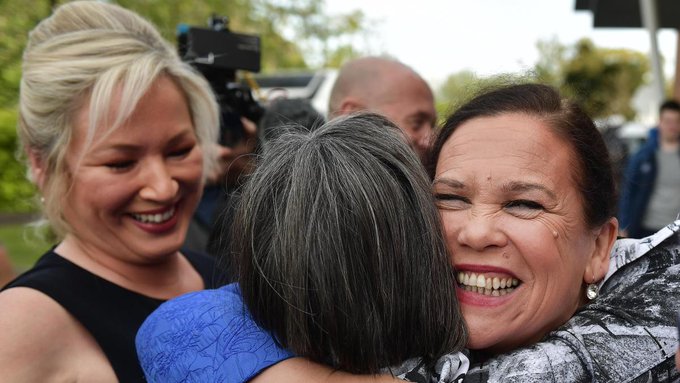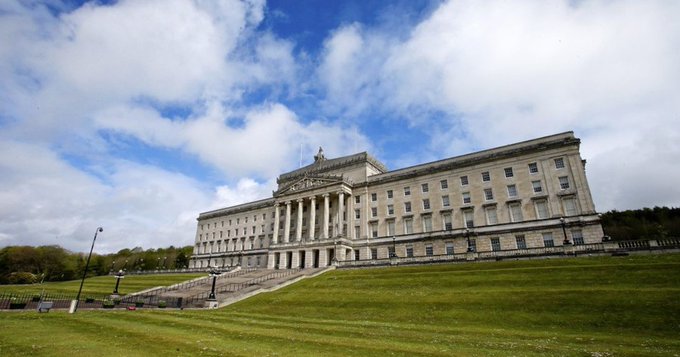This Is Not a Protocol Song
Oisin Murphy-Lawless picks over the political consequences – and demographic drivers – of the Northern Irish election results.
A week and a half on from the historic Stormont elections, and it must feel to many outwith Northern Ireland as if nothing has changed. Media and political attention is back on the Democratic Unionist Party (DUP), the Northern Irish Protocol, and a very familiar and tired set of talking points. This focus ends up overlooking the election itself, which is a shame, because even basic analysis of the results suggests some clear indicators as to where party politics in the North might be moving (be assured, this analysis will be very basic).
Turnout in this election remained strong at 63.6%, marginally down on 2017’s 64.8%. This is impressive when you look at the historical decline of turnout in Assembly elections since 1998, and doubly so when you take into account that the electoral register increased in 2021. A further 119,000 voters were added, and according to the Electoral Commission registration, numbers increased across all age bands. Growth in registration could have meant a greater drop in turnout percentage, but that has not been the case. In fact, actual votes cast increased to 873,787, the largest number recorded in the history of the current Assembly.
Recall that 2017 was the first time the DUP had lost seats in an election since 2003. In 2016, they had retained their 38 MLAs on a turnout of 54%, but the following year saw them lose 10 seats. Whilst 2022’s drop to 25 seats is not as drastic, it is hard to ignore the correlation between a high turnout and the fall in DUP MLAs. In addition, the DUP’s share of first preference votes dropped from 28.1% to 21.3%. This should all add up to a worrying turn of events for the party’s strategists and leadership.

The startling increase in the centrist Alliance Party of Northern Ireland (APNI) MLAs may be especially concerning to the DUP. Their numbers increased dramatically from 8 in 2017 to 17 this year. It is their highest number of seats since the establishment of the current Northern Irish Assembly in 1998. The 9 seats were gained from the DUP, Social Democratic and Labour Party (SDLP) and the Greens (who have now lost all their MLAs). Of particular note was Dr Patricia O’Lynn’s victory over the DUP’s Mervyn Storey in North Antrim. This is a staunchly unionist constituency which has not voted for an APNI representative since 1982, and has never voted in a woman. Storey had been an MLA since 2003 and was a senior hardline DUP member who had served in cabinet, so this was a significant win.
It may be a harbinger of things to come in other constituencies if turnout holds up at the next election. Dr O’Lynn got in on the sixth count, overtaking Storey’s vote total, on what looks to be transfers from the eliminated SDLP candidate. Each of the Unionist parties (DUP, Ulster Unionist Party (UUP) and the Traditional Unionist Voice (TUV)) fielded two candidates in the constituency, with the nationalist parties of Sinn Féin (SF) and SDLP only putting forward one each. Given that the SDLP transfers to the Dr O’Lynn beat out the transfers to the DUP, it begs the question of whether support for more hardline unionist candidates is dwindling.
The TUV vote is also worth noting here. Prior to the election, there was media focus on whether the TUV would benefit from some voters seeing the DUP as not tough enough. The TUV tripled their share of first preference votes from 20,523 in 2017 to 65,788. But they still have only one seat to show for their efforts (Party leader Jim Allister), and as North Antrim shows, even in their heartland they could not carry a second candidate over the line. An interview with the DUP peer Nigel Dodds on BBC Radio Ulster over the election weekend suggested there is no love lost between the two parties. He complained of aggressive campaigns being run by the TUV against DUP candidates. As long as that difficulty remains, hardline unionism could see continued situations like North Antrim, where competition between the two parties mean they field too many people.

Furthermore with UUP only losing one seat, there still seems to be a home for a more socially-liberal interpretation of unionism. Analysis of transfers by the Assembly’s Research and Information Service suggest good vote management, with UUP transfers principally coming from other UUP candidates (53%), followed by smaller contributions from the TUV (15%) and DUP (13%).
The huge jump in APNI MLAs has been characterised by some commentators as a growth of the non-sectarian, mostly constitutionally-neutral, middle ground. But analysis suggests this might be an incorrect reading. All of the APNI seat gains got in on transfers, rather than being voted in on the first count. The majority of these transfers came from the UUP (23%), SDLP (16%) and SF (21%). It is perhaps more accurate to say that UUP and nationalist voters trust APNI enough to help their candidates over the line.
The former APNI Executive Director, Gerry Lynch, even wondered whether there is a floating pool of younger voters between APNI and SF, noting that in West Tyrone, with SDLP still in the race, the SF candidate got 17% of the transfers. It is an intriguing interpretation of the result, and further evidence that counters the narrative of a rush to a middle ground between nationalism and unionism. It is also worth noting that the Alliance party support itself is not straightforwardly non-aligned, as Cathal McManus noted this week. His analysis of the Northern Ireland Life and Times survey suggested the party’s supporters have a mix of views on the constitutional question. In the main they seem driven to the Alliance as much by frustration with a lack of movement on other policies by SF and DUP as they are by a need to occupy some political centre ground.
Set against all these shifts, SF’s victory seems very unexciting, with exactly the same number of seats as in 2017 and a 1.1% increase in first preference votes. Yet as BBC Newsnight’s Lewis Goodall noted, it remains the most important, historic result of all. They made it through the COVID pandemic, including controversy over the handling of the Bobby Storey funeral and lockdown regulations, managed their vote transfers well and consolidated their position. The symbolic nature of the victory to nationalists and many Catholics is huge. One old family friend I know of, someone who left the North as an adult and is now in her 70s, said she is still pinching herself – she cannot quite believe that a Catholic like her is now in a position to become First Minister.
Does it mean a further imminent threat to the union? My guess is probably, but not immediately. Whilst Northern Ireland has the right under the Good Friday Agreement to hold a referendum to determine their status, it would require the Secretary of State to say the conditions were right. Last year’s Lucid Talk poll for the Belfast Telegraph still put support for the union on 49%, although it did show a 37% majority in favour of a referendum in the next 5 years. Just this month, an Irish News poll reported 35% support for United Ireland. Even if SF are in power north and south, no nationalist could look at those figures and think it wise to call for a referendum immediately.
Although talk of a referendum is more common these days in Irish politics south of the border, government preparations to date have been slow under the current Taoiseach, Micheál Martin. The main focus on north-south relations is the Shared Island Unit that promotes dialogue and further development of an all-island economy. So there is a lot of preparatory work to be done.
Regardless, the next Assembly (when it is finally up and running), will be an interesting place. The number of women have increased to 35% (SF now have more female MLAs than male). My partner, Dr Rena Maguire, took a look at the ages of the current crop of MLAs, and both SF and the APNI are skewing younger, with the DUP having the greatest number of MLAs over 60. I have yet to compare these numbers to 2017 to see whether the Assembly has got more youthful, but the age profile should not be overlooked, nor should the hefty representation of women in both APNI and SF.
It all combines for a grim outlook for the DUP if they continue their current course and insist on not nominating either speaker or a Deputy First Minister. The Northern Irish economy is currently considered one of the best performing UK regions, with more than half of its manufacturers seeing growth this year. As the cost of living problems look to be exacerbated by inflation, and the NHS continues to struggle, people will inevitably ask why Stormont cannot help them when they face economic difficulties and poverty. The only answer is ‘The DUP won’t let us’.
Under the New Decade, New Approach agreement of 2021, all Northern Ireland parties have six months to agree on power-sharing before returning to polling stations. If the DUP party leadership think that half a year of cost-of-living crisis and a winter election will help their position, I suspect the voters will correct them of that notion in a most brutal fashion.

Oisin..
In your second paragraph above you refer to a further 39 million voters having been added to the electoral register in 2021.
Where exactly ?
Iain, thanks for highlighting that – it’s a shocker of an error that I missed. The figure is about 119,00 extra voters registered since 2017: 1,254,709 were registered in 2017 (see here: https://www.bbc.com/news/election/ni2017/results), and the number of registered votes for 2022 was 1,373, 731 (see here: https://www.bbc.co.uk/news/election/2022/northern-ireland/results). I’ve asked Mike to update the article accordingly!
I’ve fixed that. Apologies Iain. I think the influx of 39 million people to the roll would have been a significant upset.
Interesting discussion, though I’d add one minor caveat: NI life and times is not worth the paper it’s printed on – its political support breakdown has always been laughably inconsistent with voting reality, and this skews everything else.